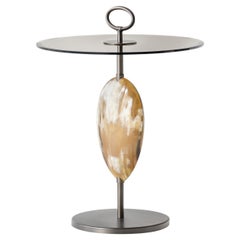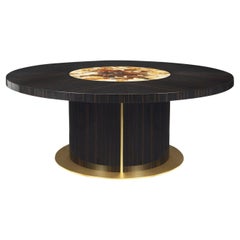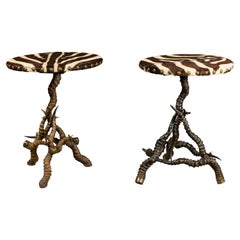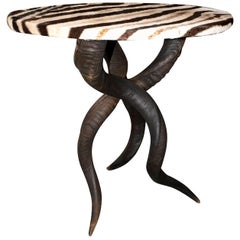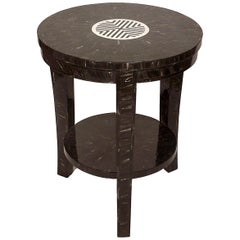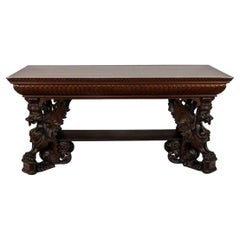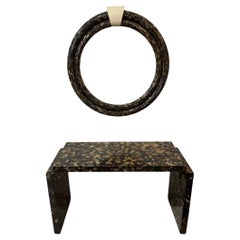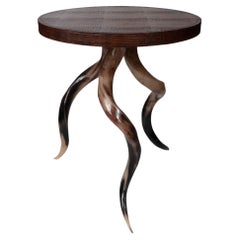Table With Horns
2010s Italian Side Tables
Brass
2010s Italian Side Tables
Stainless Steel
2010s Italian Dining Room Tables
Brass
21st Century and Contemporary Side Tables
Horn, Zebra Hide
21st Century and Contemporary French Side Tables
Horn, Animal Skin
2010s Anglo Raj Tables
Bone, Horn, Wood
Antique Late 19th Century American Victorian Desks and Writing Tables
Mahogany
Vintage 1980s Colombian Mid-Century Modern Console Tables
Bone, Horn, Mirror, Wood
2010s South African Side Tables
Horn, Leather
2010s Art Deco End Tables
Horn
2010s Art Deco End Tables
Horn
2010s South African End Tables
Horn, Cowhide
2010s Art Deco End Tables
Horn
2010s Art Deco End Tables
Horn
2010s Art Deco End Tables
Horn
2010s Art Deco End Tables
Horn
2010s Art Deco End Tables
Horn
20th Century African Rustic Side Tables
Brass
20th Century Colombian Hollywood Regency Dining Room Tables
Horn, Wood
20th Century American Mid-Century Modern Table Lamps
Brass
21st Century and Contemporary French Coffee and Cocktail Tables
Bronze
Vintage 1980s Colombian Mid-Century Modern Console Tables
Chrome
2010s Italian Console Tables
Marble, Metal
Vintage 1970s Philippine Side Tables
Metal
2010s Unknown Modern End Tables
Horn, Resin, Wood
2010s Unknown Modern End Tables
Horn, Resin, Wood
2010s Unknown Modern End Tables
Horn, Resin, Wood
Mid-20th Century French Coffee and Cocktail Tables
Horn, Leather, Smoked Glass
Antique Early 1900s Swiss Black Forest Tables
Antler, Wood
Vintage 1970s American Modern End Tables
Brass
Vintage 1970s Philippine Modern Console Tables
Bronze
Late 20th Century Unknown Hollywood Regency Coffee and Cocktail Tables
Metal
Vintage 1980s French Hollywood Regency Tables
Brass
Mid-20th Century English Mid-Century Modern Table Lamps
Metal, Brass
Vintage 1980s American Console Tables
Brass
Late 20th Century Spanish Coffee and Cocktail Tables
Metal
Mid-20th Century American Mid-Century Modern Coffee and Cocktail Tables
Horn
2010s Italian Dining Room Tables
Wood
Vintage 1970s French Mid-Century Modern Coffee and Cocktail Tables
Horn, Wood
2010s Turkish Arts and Crafts Table Lamps
Marble
2010s Turkish Arts and Crafts Table Lamps
Marble
Vintage 1970s Spanish Center Tables
Bronze
Early 20th Century French Table Lamps
Bronze, Sheet Metal
20th Century American Mid-Century Modern Coffee and Cocktail Tables
Brass
Mid-20th Century Danish Mid-Century Modern Table Lamps
Metal
Mid-20th Century French Mid-Century Modern Tables
Metal, Brass, Chrome
Mid-20th Century American British Colonial Table Lamps
Metal, Brass
Mid-20th Century American French Provincial Table Lamps
Metal, Brass
Mid-20th Century American Post-Modern Table Lamps
Brass
Early 20th Century Desks and Writing Tables
Mahogany
20th Century French Coffee and Cocktail Tables
Brass
2010s Italian Post-Modern Tray Tables
Stainless Steel
Vintage 1960s French Coffee and Cocktail Tables
Horn
21st Century and Contemporary French Console Tables
Bronze
Vintage 1970s American Coffee and Cocktail Tables
Brass
Antique 19th Century French Country Console Tables
Marble, Iron
Antique Late 19th Century German Black Forest Pier Mirrors and Console M...
Antler, Glass, Wood, Fur
- 1
Table With Horns For Sale on 1stDibs
How Much are Table With Horns?
- What are ram horns called?1 Answer1stDibs ExpertApril 5, 2022A ram’s horn is called a shofar. A shofar is a musical instrument used for Jewish religious ceremonies. The pitch of a shofar is controlled by the player’s embouchure. You’ll find a large collection of ram horn-inspired artwork from many of the world’s top sellers on 1stDibs.
- 1stDibs ExpertApril 5, 2022What a drinking horn represents is largely a matter of personal interpretation. In Greek mythology, the drinking horn is a symbol of the God Dionysus. Others associate the vessels with the Vikings or believe it to represent wealth and abundance. Shop a collection of drinking horns on 1stDibs.
- How does a drinking horn work?1 Answer1stDibs ExpertApril 5, 2022How a drinking horn works is rather simple. The hollowed-out horn holds water and other liquids. When you want to take a sip, you lift the open end to your mouth, keeping the pointed end in a downward position. On 1stDibs, shop a selection of drinking horns.
- 1stDibs ExpertApril 5, 2022The horn of a phonograph is actually just called the horn. Early phonographs played music and other sounds when grooves in records caused vibrations to travel from the stylus to the diaphragm. This caused the vibrating diaphragm to generate sound waves carried out through the horn. Find a variety of phonographs on 1stDibs.
- 1stDibs ExpertApril 5, 2022The most distinct feature of kudu horn is their shape. Male kudu antelopes grow long spiraling horns with a sleek surface that artisans can paint and carve. You'll find a selection of kudu horn furniture and decorative objects on 1stDibs.
- 1stDibs ExpertApril 5, 2022Although sizes varied, most powder horns held around 32 ounces of powder. Powder horns were popular because they were lightweight and easy to carry. Also, the horn helped to keep gunpowder dry. Shop a selection of antique powder horns on 1stDibs.
- 1stDibs ExpertAugust 20, 2024The difference between a buffet table and a console table comes down to size and storage features. Console tables are usually less deep than buffet tables, so they take up less space behind sofas and along walls. In addition, consoles are less likely to have cabinets and drawers than buffet tables, which are designed to store dinnerware and serveware in dining rooms. On 1stDibs, explore a wide variety of buffets and console tables.
- 1stDibs ExpertAugust 26, 2024The difference between a center table and a coffee table is usually size. Center tables tend to be larger-sized accent tables placed in the center of seating areas. On the other hand, coffee tables are smaller tables usually positioned in front of sofas and loveseats. On 1stDibs, find a variety of center tables and coffee tables.
- 1stDibs ExpertAugust 26, 2024The difference between a snooker table and a pool table comes down to dimensions. Generally, a snooker table is larger than a pool table, also called a billiards table. The increased size is due to the fact that a snooker game typically uses a total of 21 balls, compared to the 9 to 15 used during a pool game. Both types of gaming tables have six pockets, but those on a snooker table are usually smaller than those on a pool table because snooker balls tend to be smaller than billiard balls. On 1stDibs, find a range of billiard and snooker tables.
- 1stDibs ExpertApril 5, 2024Yes, end tables are generally taller than coffee tables.
The term “end table” is frequently used interchangeably with “coffee table,” and while these two furnishings have much in common, each table type offers its own distinctive benefits in your space.
Your end table is likely going to stand as tall as the arms of your sofa, and its depth will match the seating. These attributes allow for tucking the table neatly at the end of your sofa in order to provide an elevated surface between your seating and the wall. End tables are accent pieces — they’re a close cousin to side tables, but side tables, not unlike the show-stealing low-profile coffee table, are intended to be positioned prominently and have more to do with the flow and design of a room than an end table, which does a great job but does it out of the way of everything else.
Find all kinds of antique and vintage tables on 1stDibs. - 1stDibs ExpertOctober 7, 2024The difference between a coffee table and a console table is in the design. A coffee table is a low table that comes in many shapes, such as surfaces that are rectangles, squares, ovals or circles. Console tables are taller and usually have elongated shapes, such as ovals, rectangles or semicircles. Placement is another differentiator between the two types of tables. Coffee tables usually go in front of sofas and loveseats, while console tables may be placed behind a sofa or loveseat or along a wall. Find a large collection of coffee tables and console tables on 1stDibs.
- 1stDibs ExpertOctober 7, 2024The difference between a side table and a coffee table is mainly in the size and shape. Coffee tables usually feature larger tops but shorter legs. People typically place them in front of a sofa or a loveseat to rest books, drinks, remote controls and other items. Side tables also store items, but they are usually positioned beside an accent chair or at the ends of a sofa or loveseat. Shop a diverse assortment of side tables and coffee tables on 1stDibs.
- 1stDibs ExpertAugust 26, 2024The difference between an accent table and an end table comes down to how you use them. Accent tables function primarily as decorations and may be placed almost anywhere in a room. The purpose of an end table is to provide storage space next to a sofa or loveseat. Most people use them in pairs, with one placed on either side of the focal furnishing in a seating area. Find a large collection of accent tables and end tables on 1stDibs.
- 1stDibs ExpertFebruary 17, 2023The main difference between a drawing table and a drafting table is adjustability. Typically, drawing table writing surfaces are stationary, while most drafting tables can be tilted and moved up and down. However, some people use the terms drawing and drafting table interchangeably to describe any table with a tilted writing surface. On 1stDibs, shop a variety of drafting tables.
- 1stDibs ExpertApril 5, 2022While both pieces are relatively new to the furniture world, the main difference between them are their shapes. A cocktail table is generally square or rectangular in shape, while a coffee table tends to be oval or circular in shape. You can shop a collection of furniture from some of the world’s top sellers on 1stDibs.
- 1stDibs ExpertMay 22, 2019
The difference between a sofa table and a coffee table is that a sofa table is always behind the sofa and a coffee table is in front of it. Additionally, a sofa table is the same height as the sofa and a coffee table is much shorter.
- 1stDibs ExpertOctober 19, 2021The difference between a billiard table and a pool table is primarily the size. The basic dimensions of a billiard table are usually 10’ by 5’, whereas a pool table is a relatively smaller structure, as they’re usually 3.5’ by 7’. An additional way that these tables differ from each other is the absence of pockets on the billiard table. Shop a range of billiard and pool tables on 1stDibs.
- 1stDibs ExpertMarch 31, 2023The main difference between a bistro table and a pub table is the size. A bistro table is usually around 28 to 36 inches tall, so you can sit at it with a standard dining chair. Often, people pair bistro chairs with bistro tables. A pub table is taller at around 40 to 44 inches and requires a pub-height chair or stool for comfortable seating. Find a variety of pub and bistro tables on 1stDibs.
- 1stDibs ExpertMay 5, 2023There are two differences between end tables and side tables: function and size. Typically, end tables go beside a chair or at opposite ends of a sofa and have smaller tabletops, while side tables go toward the sides of seating areas or against walls and feature a larger surface area. However, many people use the words side and end tables interchangeably, so these differences may not always apply. On 1stDibs, shop a variety of end and side tables.
- What is a naga table?1 Answer1stDibs ExpertMay 5, 2023A naga table is a table produced by artisans from Nagaland, a region in North East India. Typically, the tables are solid hardwood, but some have iron legs. Traditionally, people used naga tables for grinding grains, but today they serve as accent tables in homes throughout the world. On 1stDibs, find a selection of naga tables.
Read More
20 Inviting Dining Rooms Perfectly Arranged for Entertaining
Top interior designers show — and tell — us how to create delectable spaces for hosting dinner parties.
This Alain Delon–Designed Table Is Almost as Handsome as He Was
Fans of the French film star may be surprised to learn that he had a flair for furniture with sleek lines and disco-era flash.
Uchronia’s Plant Stand Gives Pots a Pretty Perch with All the Trimmings
Like other pieces in the firm’s Candy Box collection, the cheerful limited-edition design showcases French craft.
The Ultimate Guide to Types of Tables for the Home
Whether you’re just moving in or ready to give your home a makeover, our guide will give you pointers on tables that are fitting for every room, nook and hallway.
Is Lionel Jadot the Willy Wonka of Upcycled Belgian Design?
From his massive collaborative workshop in a former paper factory, the designer concocts funky furniture from disused materials, as well as luxe hotel interiors like the new Mix Brussels.
Inspired by the Cosmos, Sandra Nunnerley’s Nova Table Has a Futuristic Feel
The designer’s innovative use of an unexpected material gives this console a lift.
This 19th-Century Gilded Desk Displays a Fanciful Kingdom in Marquetry
The stately piece brings both gravitas and whimsy to any work space.
In Guadalajara, These Luscious Side Tables Are Chiseled from Volcanic Rock
Use them as tables or stools, indoors or out.
